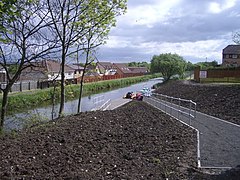world.wikisort.org - United_Kingdom
Redding is a village within the Falkirk council area in Central Scotland. The village is 2.1 miles (3.4 km) southeast of Falkirk, 1.9 miles (3.1 km) south-southwest of Grangemouth and 1 mile (1.6 km) west of Polmont.
This article needs additional citations for verification. (May 2015) |
Redding
| |
|---|---|
 Slipway to the Union Canal at Redding | |
 Redding Location within the Falkirk council area | |
| Population | 3,860 (mid-2020 est.)[1] |
| OS grid reference | NS923786 |
| • Edinburgh | 21.2 mi (34.1 km) ESE |
| • London | 343 mi (552 km) SSE |
| Civil parish |
|
| Council area | |
| Lieutenancy area |
|
| Country | Scotland |
| Sovereign state | United Kingdom |
| Post town | Falkirk |
| Postcode district | FK2 |
| Dialling code | 01324 |
| Police | Scotland |
| Fire | Scottish |
| Ambulance | Scottish |
| UK Parliament |
|
| Scottish Parliament |
|
| Website | falkirk.gov.uk |
At the time of the 2001 census, Redding had a population of 1,954 residents.[2]
History

On a hill beyond Redding is a stone that is called Wallace's stone, marking out the spot from which Sir William Wallace, after his quarrel with Sir John Stuart, one of the Scottish chiefs, is said to have viewed the Battle of Falkirk, from which he had been compelled to retire, and to have witnessed the defeat of the Scottish army.[citation needed] The village is one of the older settlements in the area and is shown on Timothy Pont's map of Stirlingshire from around 1590.[3]
In 1923, the small mining community of Redding was the scene of one of the worst disasters in the history of the Scottish coalfield, which claimed the lives of 40 men. At 5.00am on Tuesday 25 September 1923 an inrush of water flooded the pit.[4] The Sir William Wallace Lodge of the Grand Lodge of Scotland Free Colliers still march every year on the first Saturday in August in memory of the men who lost their lives in the disaster.[5][6]
See also
- Falkirk Braes villages
- List of places in Falkirk council area
References
- "Mid-2020 Population Estimates for Settlements and Localities in Scotland". National Records of Scotland. 31 March 2022. Retrieved 31 March 2022.
- No 3 - 2001 Census Population of settlements and wards Archived 3 June 2011 at the Wayback Machine www.falkirk.gov.uk. Retrieved 2011-05-11
- Hood, John (2022). Old Polmont, Laurieston, Redding and Brightons (3 ed.). Catrine: Stenlake Publishing Ltd. ISBN 978-1-84033-911-6.
- Throwback Thursday: Fundraising - 1923 Style, Falkirk FC, 18 June 2020
- "Falkirk Local History Society". falkirklocalhistorysociety.co.uk.
- "Last lodge of Free Colliers". Herald Scotland. 16 January 1993.
External links
Другой контент может иметь иную лицензию. Перед использованием материалов сайта WikiSort.org внимательно изучите правила лицензирования конкретных элементов наполнения сайта.
WikiSort.org - проект по пересортировке и дополнению контента Википедии